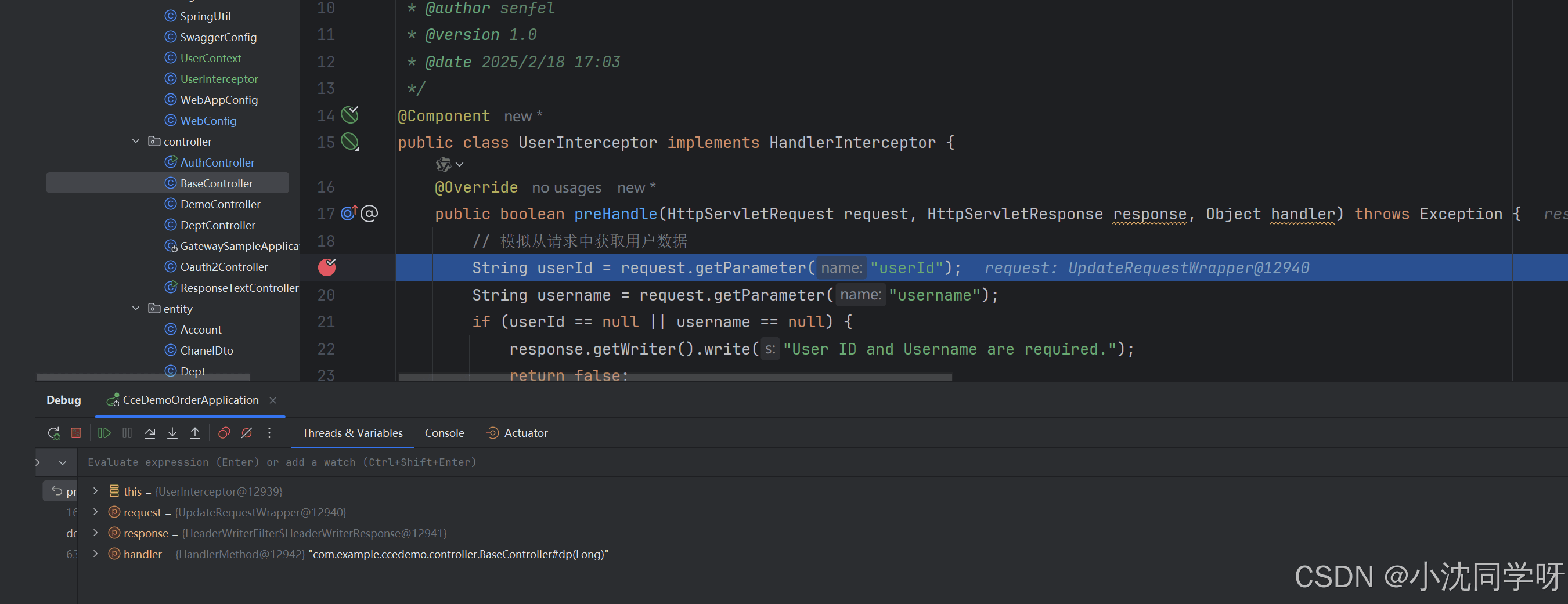前言
在多线程编程中,线程安全是一个重要的问题。java 提供了多种机制来处理线程安全问题,其中 threadlocal 是一个非常有用的工具。本文将详细介绍 threadlocal 的原理及其在多线程上下文管理中的应用,并在springboot中使用threadlocal保存请求中携带的用户信息。
技术积累
1.什么是 threadlocal
threadlocal 是 java 提供的一个类,用于在多线程环境下为每个线程维护独立的变量副本。这意味着每个线程都可以独立地访问和修改自己的变量副本,而不会影响其他线程的变量。
2. threadlocal 的原理
2.1 线程隔离
每个线程都有一个 threadlocalmap 对象,该对象存储了所有 threadlocal 变量的副本。threadlocalmap 是 thread 类的一个内部类,每个线程实例都有一个 threadlocalmap 实例。
2.2 存储机制
设置值: 当一个线程调用 threadlocal.set(value) 时,threadlocal 会将值存储到当前线程的 threadlocalmap 中。
获取值: 调用 threadlocal.get() 时,threadlocal 会从当前线程的 threadlocalmap 中获取值。
2.3 内存管理
弱引用: threadlocalmap 使用弱引用(weakreference)来存储 threadlocal 对象,以防止内存泄漏。
清理: 当 threadlocal 对象不再被使用时,它可以被垃圾回收,从而避免内存泄漏。
3. 使用场景
3.1 用户会话管理
在 web 应用中,可以使用 threadlocal 存储用户会话信息,确保每个请求处理线程都能访问到正确的会话数据。
3.2 事务上下文管理
在数据库操作中,可以使用 threadlocal 存储事务上下文,确保每个线程的操作都在正确的事务中进行。
3.3 线程局部变量
在多线程环境中,需要每个线程拥有独立的变量副本时,可以使用 threadlocal。
4. 示例代码
以下是一个简单的示例,展示了如何使用 threadlocal 来管理每个线程的独立变量。
public class threadlocalexample {
// 创建一个 threadlocal 实例
private static final threadlocal threadlocal = new threadlocal<>();
public static void main(string[] args) {
// 创建多个线程
for (int i = 0; i < 5; i++) {
new thread(() -> {
// 为每个线程设置不同的值
threadlocal.set((int) (math.random() * 100));
try {
// 模拟线程执行时间
thread.sleep(1000);
} catch (interruptedexception e) {
e.printstacktrace();
}
// 获取并打印当前线程的值
system.out.println("thread " + thread.currentthread().getid() + ": " + threadlocal.get());
// 清除 threadlocal 变量,避免内存泄漏
threadlocal.remove();
}).start();
}
}
}4.1 关键点
线程隔离: 每个线程都有独立的 threadlocal 变量副本。
内存管理: 使用 threadlocal.remove() 清除不再需要的变量,避免内存泄漏。
性能考虑: threadlocal 的使用会增加一定的内存开销,因此在不需要时应及时清理。
5. 注意事项
5.1 内存泄漏
如果不及时清理 threadlocal 变量,可能会导致内存泄漏。因此,建议在使用完 threadlocal 变量后调用 remove() 方法。
5.2 线程池
在使用线程池时,线程可能会被重用。如果 threadlocal 变量没有被清理,可能会导致后续任务访问到错误的数据。因此,在使用线程池时,务必在任务执行完毕后清理 threadlocal 变量。
实战演示
1. user 类
user 类表示用户数据
/**
* user
* @author senfel
* @version 1.0
* @date 2025/2/18 17:00
*/
@allargsconstructor
@noargsconstructor
@data
public class user {
private string id;
private string username;
}2. usercontext 类
usercontext 类使用 threadlocal 来存储和删除用户数据。
/**
* usercontext
* @author senfel
* @version 1.0
* @date 2025/2/18 17:01
*/
public class usercontext {
// 创建一个 threadlocal 实例来存储 user 对象
private static final threadlocal<user> userthreadlocal = new threadlocal<>();
// 设置用户数据
public static void setuser(user user) {
userthreadlocal.set(user);
}
// 获取用户数据
public static user getuser() {
return userthreadlocal.get();
}
// 删除用户数据
public static void clearuser() {
userthreadlocal.remove();
}
}3.userinterceptor 类
userinterceptor 类用于在请求处理前后设置和清除 threadlocal 中的用户数据。
/**
* userinterceptor
* @author senfel
* @version 1.0
* @date 2025/2/18 17:03
*/
@component
public class userinterceptor implements handlerinterceptor {
@override
public boolean prehandle(httpservletrequest request, httpservletresponse response, object handler) throws exception {
// 模拟从请求中获取用户数据
string userid = request.getparameter("userid");
string username = request.getparameter("username");
if (userid == null || username == null) {
response.getwriter().write("user id and username are required.");
return false;
}
// 创建 user 对象并存储在 threadlocal 中
user user = new user(userid, username);
usercontext.setuser(user);
return true;
}
@override
public void aftercompletion(httpservletrequest request, httpservletresponse response, object handler, exception ex) throws exception {
// 清除 threadlocal 中的用户数据,避免内存泄漏
usercontext.clearuser();
}
}4.配置拦截器
在 spring boot 中配置拦截器,使其在请求处理前后执行。
/**
* webconfig
* @author senfel
* @version 1.0
* @date 2025/2/18 17:10
*/
@configuration
public class webconfig implements webmvcconfigurer {
@autowired
private userinterceptor userinterceptor;
@override
public void addinterceptors(interceptorregistry registry) {
registry.addinterceptor(userinterceptor).addpathpatterns("/**");
}5.实战测试
随便访问一个路径,都会从请求中获取用户信息并放入local,在执行控制器结束后会清理掉数据。


总结
threadlocal 是一个非常强大的工具,可以帮助我们在多线程环境中管理线程局部变量。通过合理使用 threadlocal,可以有效地避免线程安全问题,提高程序的并发性能和稳定性。我们可以在 spring boot 应用中安全地存储和管理每个请求的用户数据,并通过显式地清理 threadlocal 变量,可以有效避免内存泄漏问题。
到此这篇关于springboot中使用 threadlocal 进行多线程上下文管理及其注意事项的文章就介绍到这了,更多相关springboot threadlocal多线程上下文管理内容请搜索代码网以前的文章或继续浏览下面的相关文章希望大家以后多多支持代码网!






发表评论